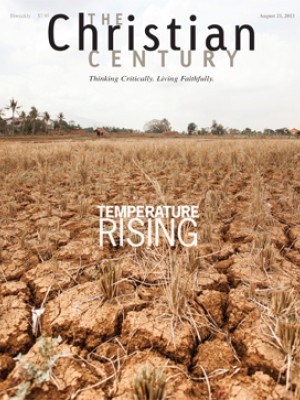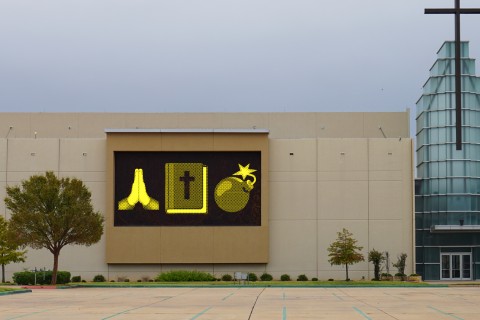Neighbors in Christ: Global Christianity in the city

In 1961, a Time cover story declared that the “ecumenical century” was at hand. Pope John XXIII’s “ecumenical council”—aka Vatican II—was forthcoming, while the National Council of Churches had made progress in the United States. And in New Delhi, the World Council of Churches held its third assembly—with the full participation of many Orthodox churches, nearly all of which by then had officially joined the WCC. Time optimistically claimed that “the scattered forces of Christian faith are realigning and regrouping.”
The New Delhi assembly adopted a statement on unity. The statement, which was shaped by the WCC’s Faith and Order Commission meeting the previous year, emphasized that unity needed to be pursued both in local settings and at a global level:
We believe that the unity which is both God’s will and his gift to his Church is being made visible as all in each place who are baptized into Jesus Christ and confess him as Lord and Saviour are brought by the Holy Spirit into one fully committed fellowship . . . and who at the same time are united with the whole Christian fellowship in all places.
Read our latest issue or browse back issues.
The phrases “in each place” and “in all places” captured the document’s essence and took on an enduring life of their own. The New Delhi assembly is remembered for insisting that church unity does not just occur through the drama of global ecumenical gatherings. It must simultaneously take place in the local areas where congregations exist in close proximity.
Fifty years later, national and local councils of churches exist throughout the world. So we may be tempted to see little challenge in the New Delhi statement. But world Christianity’s geographical presence has changed dramatically—and migration from the Global South to the North has affected the religious landscape of northern cities. In light of all this, the New Delhi statement comes alive with new prescience and meaning.
Three-fourths of all immigrants to the U.S. live in six states: California, Texas, New York, Florida, New Jersey and Illinois. They are drawn especially to major metropolitan areas. A third of all foreign-born residents live in New York and Los Angeles. LA alone is home to 19 percent of Asian immigrants.
Suburbs are part of the story too: Chicago has 590,000 immigrants, while 984,000 foreign-born residents live in the city’s suburbs. Nearly all the major metropolitan areas of the United States are home to concentrated groups of foreign residents, especially the largest cities and those on the Eastern Seaboard and the West Coast.
In recent years, the number of immigrants has grown rapidly in many cities. By 2010, Charlotte, Raleigh, Nashville and Indianapolis each had more than 100,000 foreign-born residents. In the past decade, cities with the fastest growth rate of immigrants include Baltimore (72 percent), Orlando (71 percent), Las Vegas (71 percent) and Atlanta (69 percent).
About two-thirds of these immigrants are Christians. They come to American cities and establish monoethnic congregations or join multiracial churches. They find ways to nurture and deepen their faith among the community of believers in these local places.
Similar movements are at work in Europe, where they’ve received far more study than in the U.S. Jehu Hanciles estimates that on a given Sunday in London, 58 percent of churchgoers are nonwhite. Hamburg has 60 African congregations and an African Christian Council. The Protestant Church in the Netherlands supports an organization called Samen Kirk in Nederland, which links together 67 migrant churches. In Spain, 30 percent of the membership of the Federation of Evangelical Religious Entities originates in Latin America or Africa.
Europe’s largest church was founded in Kiev by a Pentecostal from Nigeria. Sunday Adelaja started the Church of the Embassy of the Blessed Kingdom of God for All Nations with seven people in 1993. Today it claims 25,000 members in Kiev and has started hundreds of churches elsewhere. Ten years ago, the church began to focus its outreach on the poor, people with addictions and other marginalized groups. As much as 90 percent of its membership is now Ukrainian or Eastern European.
In 1961, Western mission agencies were flourishing, with plentiful resources to send missionaries to countries in the Global South and East. The WCC delegates in New Delhi didn’t foresee the eventual migration of Christians from these countries back to the West—as “missionaries” within societies where Christendom has collapsed. No one could have imagined how much world Christianity would change in 50 years.
Yet the wisdom of the New Delhi statement transcends its time. Efforts to search for Christian unity and make it visible must be rooted and take hold “in each place.” In his last essay before his death, theologian John Howard Yoder put it this way:
If the dividedness of the body of Christ is to be healed, that must happen where it is experienced as a wound, and that is locally, where people who live together as neighbors and work together as colleagues are kept from worshipping together by constraints imposed from outside their shared world.
Many North American and European cities contain an astonishingly vivid and almost fully representative presence of world Christianity. So in these places, the unity of the body of Christ must be discovered, nurtured and celebrated. And these are new laboratories for a changing ecumenical paradigm more broadly. In such places, fresh initiatives could produce pathways and keys toward discovering the unity of the church at the global level.
But at present this is far from an ecumenical priority. In some such urban centers, no functioning council of churches exists. Others do have a council, but immigrant congregations are not part of it.
Some exceptions to this pattern appear in Europe. When Churches Together in Britain and Ireland was founded in 1990 (as the Council of Churches in Britain and Ireland), it included 65 African independent congregations. There’s a Federation of African Christian Churches in Brussels and a Conference of African Churches in Switzerland. Hamburg has one of Europe’s highest concentrations of Ghanaian Christians, and Deji Ayegboyin reports that the city’s African Christian Council describes its ecumenical task as “communication, reconciliation, and liberation from the walls that have been erected by the scatteredness of Christianity.”
But on the whole—and especially in the United States—ecumenical imagination has not extended to creating new local places of fellowship, mutuality and mission among the rich diversity of congregations in major metropolitan areas. This should be one of the frontiers in the pilgrimage of Christian unity in the Global North.
What if this challenge were taken seriously? What would a commitment to start such a fellowship in Houston or Baltimore or west suburban Chicago look like? How would such a new ecumenical body form itself, and what would it do?
Find out who is there and get to know one another. The first step is to discover the immigrant congregations that already exist but go unnoticed and neglected by others. This requires attentive work. Then, as in all ecumenical efforts, the starting point is building personal relationships. People—including pastors and denominational leaders—join an ecumenical fellowship or council because they have developed trusting relationships with its key leaders. Relationships are the foundation for any fresh effort for church unity.
Listen to one another’s stories of faith. A major metropolitan area contains Orthodox priests, evangelical personalities, Korean pastors, Hispanic Pentecostals, African independent church leaders, Catholic bishops, Methodist ministers, African American pastors, Lutheran bishops, Indonesian Presbyterians, Nigerian Baptists, Coptic Christians and Kenyan Anglicans—and that’s just a sample. A fresh initiative among such a group of unacquainted Christians requires listening to one another’s stories of Christian pilgrimage.
Sharing stories is a simple yet powerful way to build trust that can transcend—or at least suspend—the various stereotypes, assumptions and unspoken judgments that most will bring into the room. This practice should become a regular feature of such an ecumenical initiative.
Enter into theological dialogue. As trust begins to grow, the bonds of community begin to feel secure enough to be tested. At this point, participants in an emerging ecumenical body can enter into activities together. One project is theological exchange. It’s essential that the churches that define world Christianity—and that are present in large urban areas—have deep theological encounters with one another.
Work together for justice. Local issues of immigration, poverty, human trafficking and environmental destruction can be cooperatively addressed. The potential for common ground for action in some of these areas is wider than some might assume. And when nearly all the churches in a city are united around a common social issue, they have a significant capacity to make a difference.
Explore common mission and evangelism. A growing ecumenical fellowship should explore areas of common witness, mission and evangelism. Here is where the interchange can become especially engaging and creative. Many immigrant congregations in large cities experience the U.S. as a materialistic, hedonistic, secularized society. They often convey the sense that they are part of a plan for carrying out God’s mission here; some have even been sent with that explicit purpose. Sharing this missional call with others—and hearing how churches respond—will be mutually enriching.
Worship and pray together. All activities of an ecumenical fellowship must be undergirded by worship, prayer and celebration. This dimension of cooperation presents deep challenges, but the group will discover that some of its richest experiences come as participants learn how to pray and worship together. Christian Churches Together in the USA has adopted the practice of having five different worship services throughout the course of its annual meeting. Each service is led by representatives of one of the group’s five Christian “families”: Catholic, evangelical/Pentecostal, historic Protestant, Orthodox and the historic black churches. This has proved more edifying than a lowest-common-denominator approach to worship.
What’s the overall goal of those who gather, share life in one city and pray for that city’s sake? First, that they might—in the words of the New Delhi statement—“be brought by the Holy Spirit into one fully committed fellowship”:
It is a fellowship of those who are called together by the Holy Spirit and in baptism confess Christ as Lord and Saviour. They are thus “fully committed” to him and to one another. Such a fellowship means for those who participate in it nothing less than a renewed mind and spirit, a full participation in common praise and prayer, the shared realities of penitence and forgiveness, mutuality in suffering and joy, listening together to the same Gospel, responding in faith, obedience and service, joining in the one mission of Christ in the world, a self-forgetting love for all for whom Christ died, and the reconciling grace which breaks down every wall of race, colour, caste, tribe, sex, class and nation.
This is the vision at the heart of this ecumenical calling that seeks expression in local metropolitan settings. Implementing this vision would mobilize the churches in their mission and work together for the sake of God’s justice in the city. The words of the prophet Jeremiah, given to the people of Israel when they became strangers and sojourners in a land not their own, would come to life: “Seek the welfare of the city where I have sent you into exile, and pray to the Lord on its behalf, for in its welfare you will find your welfare” (Jer. 29:7).
My suggestions for the dimensions of local ecumenical activity—theological exchange, joint action and common mission, undergirded by worship and prayer—echo the historic streams forming the WCC and shaping its life. This basic agenda is not the problem. It still holds as a coherent and compelling framework for what we pray for the churches to do together, emerging out of their fellowship.
The pressing issue instead is this: Who are the partners participating in such an ecumenical agenda? The growing, emerging parts of world Christianity—the groups that will shape the faith’s future—generally are not ecumenical partners in theological dialogue, or in shared actions for God’s justice and reign in the world, or in common mission and evangelism. We need new, broadly inclusive experiences of such fully committed fellowship “in each place.” As this happens, the ecumenical agenda will be enlivened, transformed and radically renewed.
This article is excepted from Times Square to Timbuktu: A Post-Christian West Meets the Non-Western Church, just published by Eerdmans.






